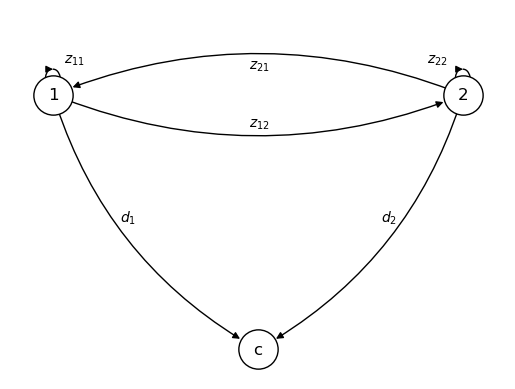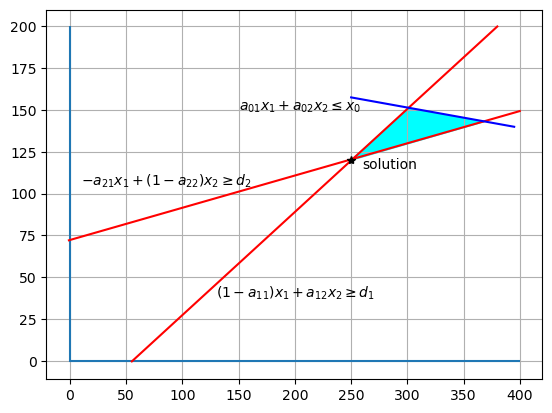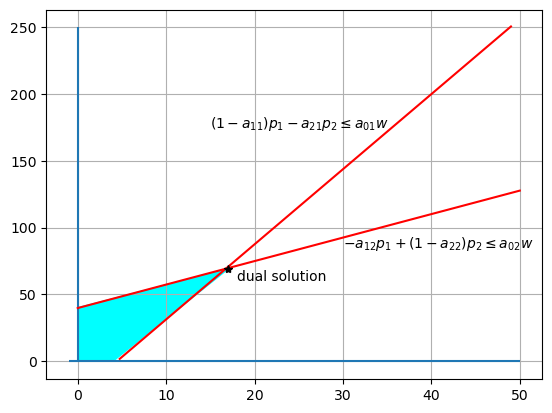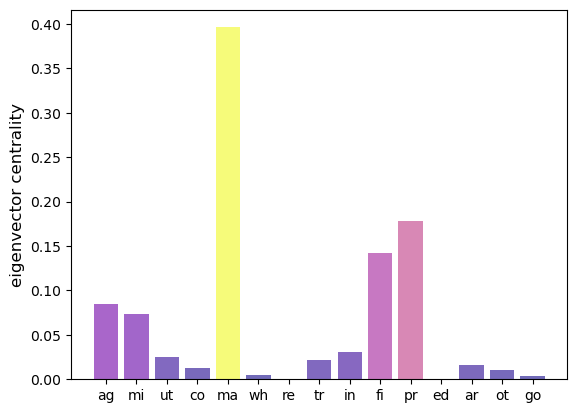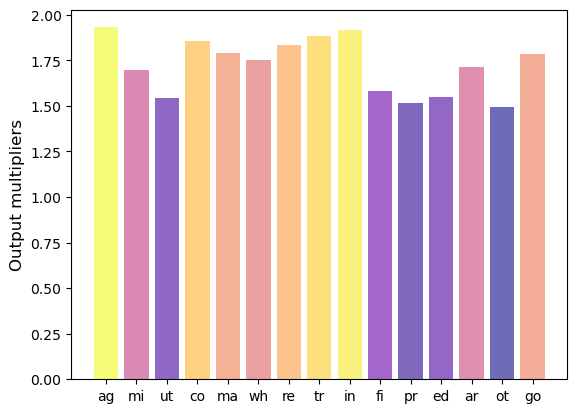40. Input-Output Models#
40.1. Overview#
This lecture requires the following imports and installs before we proceed.
!pip install quantecon_book_networks
!pip install quantecon
!pip install pandas-datareader
import numpy as np
import networkx as nx
import matplotlib.pyplot as plt
import quantecon_book_networks
import quantecon_book_networks.input_output as qbn_io
import quantecon_book_networks.plotting as qbn_plt
import quantecon_book_networks.data as qbn_data
import matplotlib as mpl
from matplotlib.patches import Polygon
quantecon_book_networks.config("matplotlib")
mpl.rcParams.update(mpl.rcParamsDefault)
The following figure illustrates a network of linkages among 15 sectors obtained from the US Bureau of Economic Analysis’s 2021 Input-Output Accounts Data.
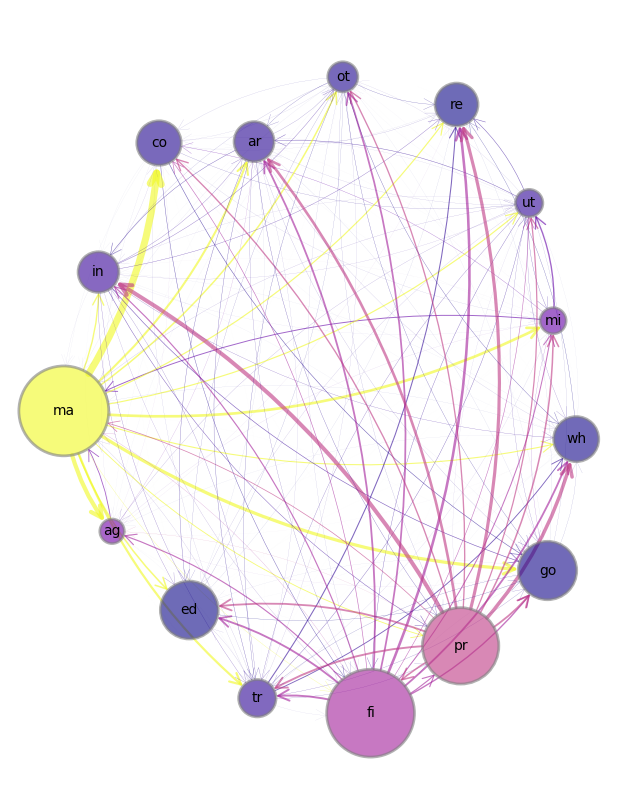
Fig. 40.1 US 15 sector production network#
Label |
Sector |
Label |
Sector |
Label |
Sector |
|---|---|---|---|---|---|
ag |
Agriculture |
wh |
Wholesale |
pr |
Professional Services |
mi |
Mining |
re |
Retail |
ed |
Education & Health |
ut |
Utilities |
tr |
Transportation |
ar |
Arts & Entertainment |
co |
Construction |
in |
Information |
ot |
Other Services (exc govt) |
ma |
Manufacturing |
fi |
Finance |
go |
Government |
An arrow from \(i\) to \(j\) means that some of sector \(i\)’s output serves as an input to production of sector \(j\).
Economies are characterised by many such links.
A basic framework for their analysis is Leontief’s input-output model.
After introducing the input-output model, we describe some of its connections to linear programming lecture.
40.2. Input-output analysis#
Let
\(x_0\) be the amount of a single exogenous input to production, say labor
\(x_j, j = 1,\ldots n\) be the gross output of final good \(j\)
\(d_j, j = 1,\ldots n\) be the net output of final good \(j\) that is available for final consumption
\(z_{ij} \) be the quantity of good \(i\) allocated to be an input to producing good \(j\) for \(i=1, \ldots n\), \(j = 1, \ldots n\)
\(z_{0j}\) be the quantity of labor allocated to producing good \(j\).
\(a_{ij}\) be the number of units of good \(i\) required to produce one unit of good \(j\), \(i=0, \ldots, n, j= 1, \ldots n\).
\(w >0\) be an exogenous wage of labor, denominated in dollars per unit of labor
\(p\) be an \(n \times 1\) vector of prices of produced goods \(i = 1, \ldots , n\).
The technology for producing good \(j \in \{1, \ldots , n\}\) is described by the Leontief function
40.2.1. Two goods#
To illustrate, we begin by setting \(n =2\) and formulating the following network.
Feasible allocations must satisfy
This can be graphically represented as follows.
More generally, constraints on production are
where \(A\) is the \(n \times n\) matrix with typical element \(a_{ij}\) and \(a_0^\top = \begin{bmatrix} a_{01} & \cdots & a_{0n} \end{bmatrix}\).
If we solve the first block of equations of (40.1) for gross output \(x\) we get
where the matrix \(L = (I-A)^{-1}\) is sometimes called a Leontief Inverse.
To assure that the solution \(X\) of (40.2) is a positive vector, the following Hawkins-Simon conditions suffice:
Example 40.1
For example a two-good economy described by
A = np.array([[0.1, 40],
[0.01, 0]])
d = np.array([50, 2]).reshape((2, 1))
I = np.identity(2)
B = I - A
B
array([[ 9.e-01, -4.e+01],
[-1.e-02, 1.e+00]])
Let’s check the Hawkins-Simon conditions
np.linalg.det(B) > 0 # checking Hawkins-Simon conditions
np.True_
Now, let’s compute the Leontief inverse matrix
L = np.linalg.inv(B) # obtaining Leontief inverse matrix
L
array([[2.0e+00, 8.0e+01],
[2.0e-02, 1.8e+00]])
x = L @ d # solving for gross output
x
array([[260. ],
[ 4.6]])
40.3. Production possibility frontier#
The second equation of (40.1) can be written
or
where
For \(i \in \{1, \ldots , n\}\), the \(i\)th component of \(A_0\) is the amount of labor that is required to produce one unit of final output of good \(i\).
Equation (40.4) sweeps out a production possibility frontier of final consumption bundles \(d\) that can be produced with exogenous labor input \(x_0\).
Example 40.2
Consider the example in (40.3).
Suppose we are now given
Then we can find \(A_0^\top\) by
a0 = np.array([4, 100])
A0 = a0 @ L
A0
array([ 10., 500.])
Thus, the production possibility frontier for this economy is
40.4. Prices#
[Dorfman et al., 1958] argue that relative prices of the \(n\) produced goods must satisfy
More generally,
which states that the price of each final good equals the total cost of production, which consists of costs of intermediate inputs \(A^\top p\) plus costs of labor \(a_0 w\).
This equation can be written as
which implies
Notice how (40.5) with (40.1) forms a conjugate pair through the appearance of operators that are transposes of one another.
This connection surfaces again in a classic linear program and its dual.
40.5. Linear programs#
A primal problem is
subject to
The associated dual problem is
subject to
The primal problem chooses a feasible production plan to minimize costs for delivering a pre-assigned vector of final goods consumption \(d\).
The dual problem chooses prices to maximize the value of a pre-assigned vector of final goods \(d\) subject to prices covering costs of production.
By the strong duality theorem, optimal value of the primal and dual problems coincide:
where \(^*\)’s denote optimal choices for the primal and dual problems.
The dual problem can be graphically represented as follows.
40.6. Leontief inverse#
We have discussed that gross output \(x\) is given by (40.2), where \(L\) is called the Leontief Inverse.
Recall the Neumann Series Lemma which states that \(L\) exists if the spectral radius \(r(A)<1\).
In fact
40.6.1. Demand shocks#
Consider the impact of a demand shock \(\Delta d\) which shifts demand from \(d_0\) to \(d_1 = d_0 + \Delta d\).
Gross output shifts from \(x_0 = Ld_0\) to \(x_1 = Ld_1\).
If \(r(A) < 1\) then a solution exists and
This illustrates that an element \(l_{ij}\) of \(L\) shows the total impact on sector \(i\) of a unit change in demand of good \(j\).
40.7. Applications of graph theory#
We can further study input-output networks through applications of graph theory.
An input-output network can be represented by a weighted directed graph induced by the adjacency matrix \(A\).
The set of nodes \(V = [n]\) is the list of sectors and the set of edges is given by
In Fig. 40.1 weights are indicated by the widths of the arrows, which are proportional to the corresponding input-output coefficients.
We can now use centrality measures to rank sectors and discuss their importance relative to the other sectors.
40.7.1. Eigenvector centrality#
Eigenvector centrality of a node \(i\) is measured by
We plot a bar graph of hub-based eigenvector centrality for the sectors represented in Fig. 40.1.
A higher measure indicates higher importance as a supplier.
As a result demand shocks in most sectors will significantly impact activity in sectors with high eigenvector centrality.
The above figure indicates that manufacturing is the most dominant sector in the US economy.
40.7.2. Output multipliers#
Another way to rank sectors in input-output networks is via output multipliers.
The output multiplier of sector \(j\) denoted by \(\mu_j\) is usually defined as the total sector-wide impact of a unit change of demand in sector \(j\).
Earlier when disussing demand shocks we concluded that for \(L = (l_{ij})\) the element \(l_{ij}\) represents the impact on sector \(i\) of a unit change in demand in sector \(j\).
Thus,
This can be written as \(\mu^\top = \mathbb{1}^\top L\) or
Please note that here we use \(\mathbb{1}\) to represent a vector of ones.
High ranking sectors within this measure are important buyers of intermediate goods.
A demand shock in such sectors will cause a large impact on the whole production network.
The following figure displays the output multipliers for the sectors represented in Fig. 40.1.
We observe that manufacturing and agriculture are highest ranking sectors.
40.8. Exercises#
Exercise 40.1
[Dorfman et al., 1958] Chapter 9 discusses an example with the following parameter settings:
Describe how they infer the input-output coefficients in \(A\) and \(a_0\) from the following hypothetical underlying “data” on agricultural and manufacturing industries:
where \(z_0\) is a vector of labor services used in each industry.
Solution to Exercise 40.1
For each \(i = 0,1,2\) and \(j = 1,2\)
Exercise 40.2
Derive the production possibility frontier for the economy characterized in the previous exercise.
Solution to Exercise 40.2
A = np.array([[0.1, 1.46],
[0.16, 0.17]])
a_0 = np.array([0.04, 0.33])
I = np.identity(2)
B = I - A
L = np.linalg.inv(B)
A_0 = a_0 @ L
A_0
array([0.16751071, 0.69224776])
Thus the production possibility frontier is given by
